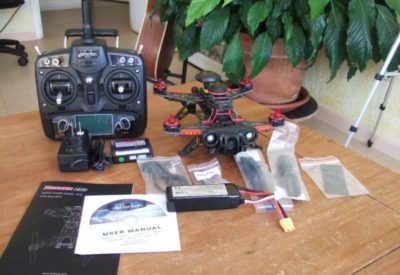If there is one thing that all drone pilots hold as being true is the fact that you have to get skilled at handling/ building/ repairing circuits and wiring. You should also get a rather skilled mechanic on your side because of all the repair work that you will be making. While this is true for the vast majority of drones out there, the same cannot be said about the Walkera Runner 250.
From the very box that it comes in, to the very max altitude that it can reach, you can clearly see that this drone was made to last and take a lot of punishment in the process.
All the vital and semi-vital drone components are safely fastened and secured behind its thick metal frame which absorbs any shock and impact damage, making the drone withstand crashes, stress, and shocks that other drones would not be able to.
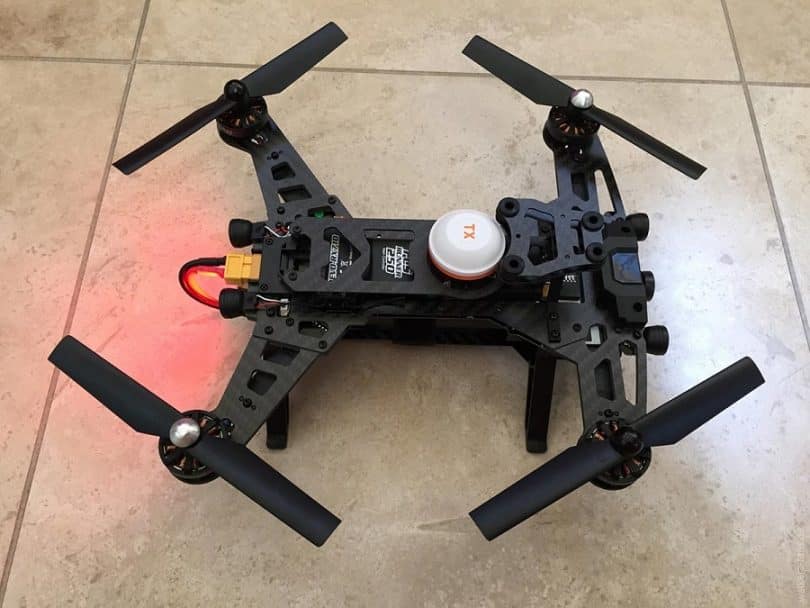
The Runner 250 is an RTF drone, meaning that it comes assembled in the box with minimal assembly required from the user in order for it to fly. The standard components will have to be installed, though, like the battery pack and the propellers, as well as the optional camera.
One thing that you will notice right off the bat is the fact that the Runner 250 has a weird set of propellers, more chunky and robust than the standard thin long propellers that other drones sport. This is because of the fact that the Runner 250 is rather robust itself and the heavy duty frame needs a lot of force in order to be flown around.
The propellers are designed this way to move a lot more air around and generate the force required to not only lift the drone off the ground but also give it the ability to fly around and maneuver in a nimble and responsive fashion.
Another thing that sets this drone apart from all the other drones on the market is the controller itself. The runner 250 uses the DEVO 7 transmitter as its controller, making it a lot easier to fly and concentrate on the flight itself rather than the drone.
Product specifications:
- Super resistance performance.
- Carbon fiber structure feature durable performance.
- Simple to disassemble and re-assemble.
- Exteme speed with tactile control, ultra fast speed of 35-40km/h.
- Extremely long, high sensitive, remote control range.
There is a small downside to this drone however, and ironically, it comes as a result of its main strongpoint. The Runner 250 is pretty much the drone equivalent of a tank, being able to be rammed into walls, crashed, tossed around and even spun out from great altitudes at great speeds.
This means that the frame is not only sturdy but also heavy, causing the drone to reach a weight of 530g with the battery mounted on.
This, combined with the 11.1V 2200mAh standard battery, manages to give the Runner 250 an average flight time of 12-14 minutes, which is slightly lower than most drones. Technically, this flight time is to be expected because the Runner 250 is a racing drone capable of reaching very high speeds and altitudes.
One last thing to note here is the fact that the Runner 250 is a drone that was conceived with racing and endurance flights in mind. If you are interested in finding out more about this new, adrenaline-filled sport, you can also read our article about drone racing . Each and every single aspect of the drone is carefully balanced and fabricated in such a way that permits the drone to withstand a lot of punishment and still keep on flying.
Each and every single aspect of the drone is carefully balanced and fabricated in such a way that permits the drone to withstand a lot of punishment and still keep on flying.
Contents
BUILD SPECIFICATIONS Walkera Runner 250
PACKAGING
The Runner 250 comes in a flashy, yet standard package which pretty much looks like a suitcase more than anything else. Inside the shock absorbing sponge filled case you will find:
- 1 x set of 4 propellers
- 1 x battery
- 1 x battery charger
- 1 x electrical adaptor
- 1 x set of tools (3 tools in total) that will help you with the minimal maintenance work that this drone requires every now and then
- 1 x transmission cable
- 1 x DEVO 7 transmitter
- 1 x drone
As always, this is the basic standard kit, and it is often advised to purchase a few spare parts, especially if you are a beginner and not all that experienced with drones.
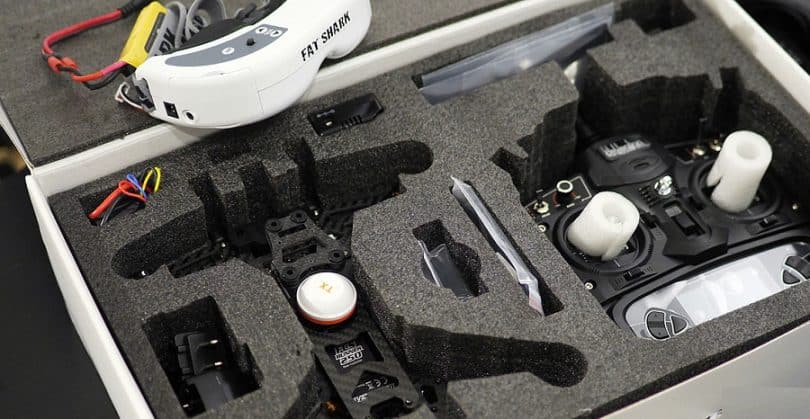
You can purchase pretty much any spare part for this particular drone, from propellers to the actual motherboard. However, the most recommended spare parts for purchase are extra batteries, propellers, and head/tail lights, mostly because these are the most probable to get damage as result of a crash.
One last thing to mention here is the fact that the tools that come in this kit are specially made, designed and measured for this drone, so make sure that you don’t misplace them and that you always have them on hand when doing maintenance /repair/ upgrade work on your drone.
DESIGN AND DURABILITY
As mentioned earlier, durability is one of the words that best describe this drone, being able to take a lot of punishment and at the same time simply get back up and keep flying.
The frame is sturdy and well-built, being able to absorb a lot of, if not all of, the stress, the shock, and the impact force that the drone has to face in case of a crash or hit. If you want to find out more about racing frames, we suggest checking out our article about quadcopter frames , where you will read the reviews of some of the best racing frames on the market.
The overall design is not as flashy or as eye-catching as the other drones on the market.
In fact, it is best described as a bare-bones design, the frame and the inner workings of the drone being exposed and visible. The motors and mechanical joints, however, are shielded and hidden.
This is not for aesthetic reasons, but in order to prevent any dust, corrosion or dirt getting in and messing with the fine machines, which is especially dangerous seeing as the Runner 250 sports a brushless motor.
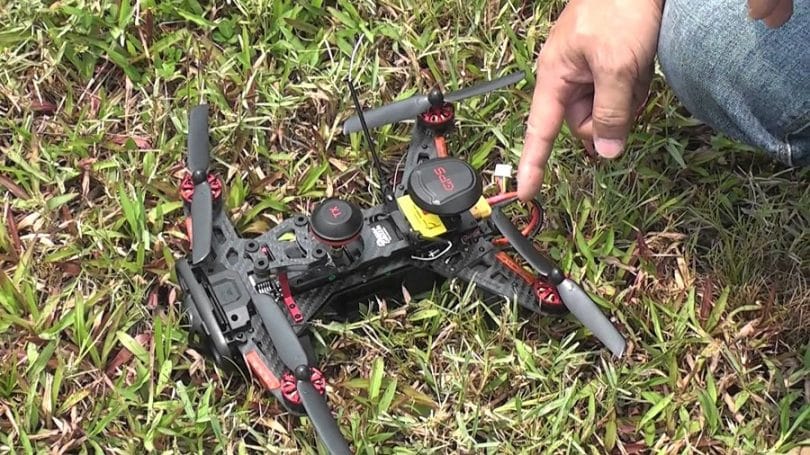
The head and tail lights are slightly bigger on this drone, making them more visible and more distinguishable from the surrounding environment. One thing that could be improved in regards to the head and tail lights design is the fact that they cannot be moved/ tilted/ panned around.
This means that in the night time the drone will illuminate what is in front of and behind it, not side to side or beneath it, making night time landings a lot more tricky and risky.
The propellers are stubbier, thicker and slightly wider than the average drone propellers. This is because of the fact that they have to compensate for the weight of the frame and actually generate a lot more lift as a result of it.
This means that a larger quantity of air needs to be moved and a larger lift surface needs to be applied to the underside of the propellers in order to not only get the Runner 250 off of the ground but also allow it to take sharp turns, reach racing speeds and still maintain a rather large level of stability.
CAMERA
The Walkera Runner 250 comes with a built-in digital camera that has the following specs:
- Horizontal resolution: 800TVL
- Video system: PAL/NTSC
- Video Out: 1.0Vp-p
- Power Input: DC 12V
This camera is pretty good as far as built-in cameras go. However, more and more people find different ways in which, they can attach different cameras to the drone.
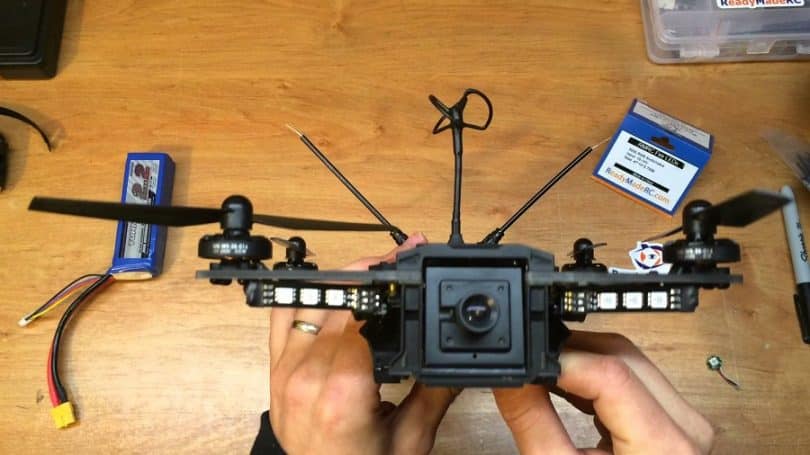
While the camera is absolutely fine for casual film clips and low budget projects, it simply does not have the resolution for high budget project shots and professional work. But then again, this is not a platform meant for aerial filming but for FPV racing.
BATTERY AND FLIGHT TIME
When it comes to the battery life and flight time, the Walkera Runner 250 falls a bit short of the mark, especially when compared to other drones and the standard batteries that they come with.
The battery itself is more or less a standard 11.1V 2200mAh Li-Ion battery, carrying the standard charge as the vast majority of drone batteries out there on the market. Still, because of the weight of the drone itself, especially the frame, the flight time is significantly reduced – on average, the flight time of the Runner 250 is 12-14 minutes.
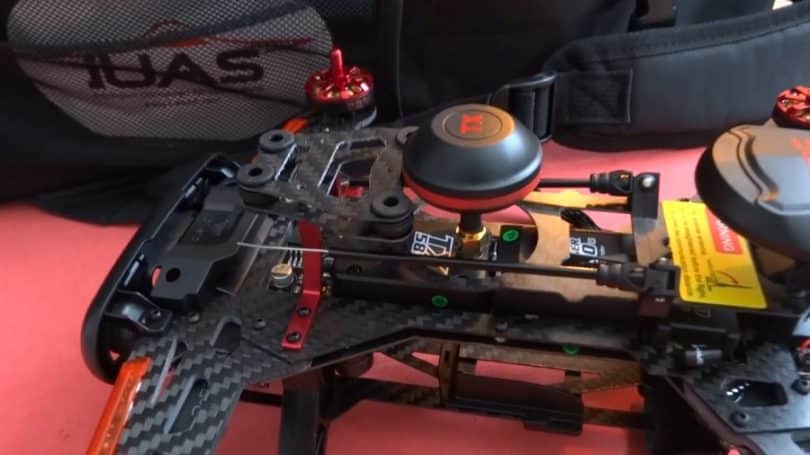
There have been attempts made to attach more than one battery to the drone, however, so far they have been unsuccessful. The drone is able to function with bigger drone batteries that hold a bigger charge. However, there are minor adjustments that have to be made to the frame as well as making sure that the drone is not thrown off balance.
One last thing to be noted here is the fact that the standard battery provided by the producer has a rather short and comfortable recharge time. Still, it is actually recommended to order spare batteries when purchasing the drone in order to make sure that you are able to fly for more than the 12-14 minute average flight time.
CONTROLLER
The Standard controller for the Walkera Runner 250 is the DEVO 7 transmitter. This allows for more comfortable and nimble flight, which is actually expected, seeing as the Runner 250 is actually a racing drone, designed to reach very high speeds and maneuver around harsh obstacles.
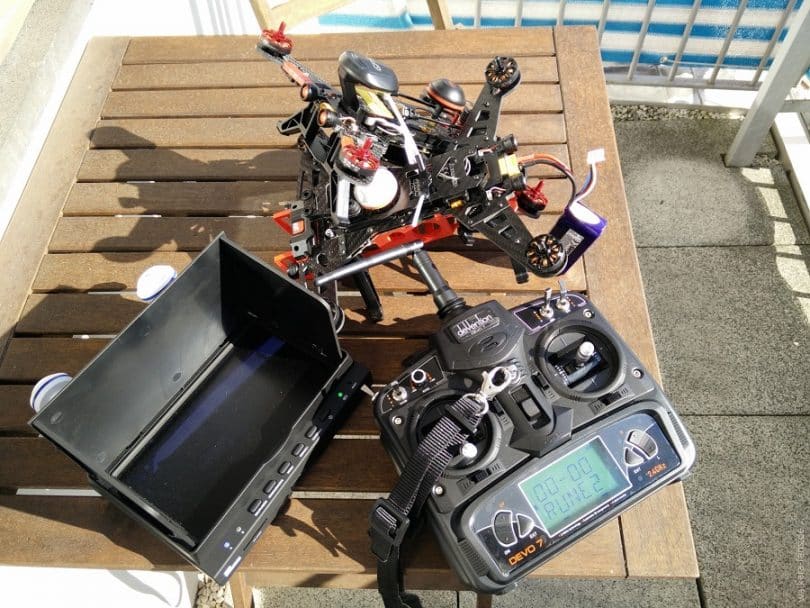
The main controls are still in the standard place, perfect for the thumbs of the pilot. However, unlike the majority of drone controllers out there, the auxiliary controls are placed towards the top of the controller, which allows for more comfortable flying and sharper maneuvering, which are crucial in races.
The bottom of the controller is reserved for flight information which is quite extensive when it comes to the drone Walkera Runner 250, as well as the range track and the coordination of the drone.
FLIGHT PERFORMANCE
When it comes to flying, the Runner 250 performs quite well, contrary to what most people expect when they see the drone for the first time.
First of all, even though the drone is over 500g heavy and quite bulky, it is still able to achieve some rather impressive speeds, as well as take some very sharp corners.
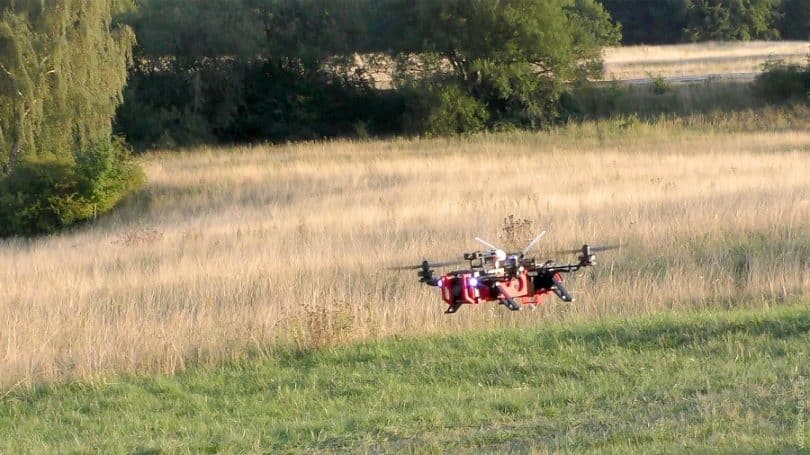
Because of the fact that the Walkera Runner 250 is a racing drone, the little motors and overall balancing of the drone is configured in such a way that the speed and agility are maximized, even though the battery life takes a hit in the process.
The drone is very nimble so skilled drone pilots will be able to do barrel rolls, flips, pancake turns and dash dives, quite easily. To top it all off, the altitude that the drone is able to reach is stretched to about the length of the transmitter signal. Still, you should keep in mind that the flight performance deteriorates the higher the drone goes.
VALUE FOR MONEY AND GUARANTEE
First and foremost, the Runner 250 is among the cheaper drones on the market, mostly because it is a bare-bone RTF drone with cheap consumables and easy to replace parts.
That being said, for around $300 you get a very sturdy and stable racing drone that is able to rise to the expectations of all drone pilots out there while at the same time providing you with a lot of safety and technical protection.
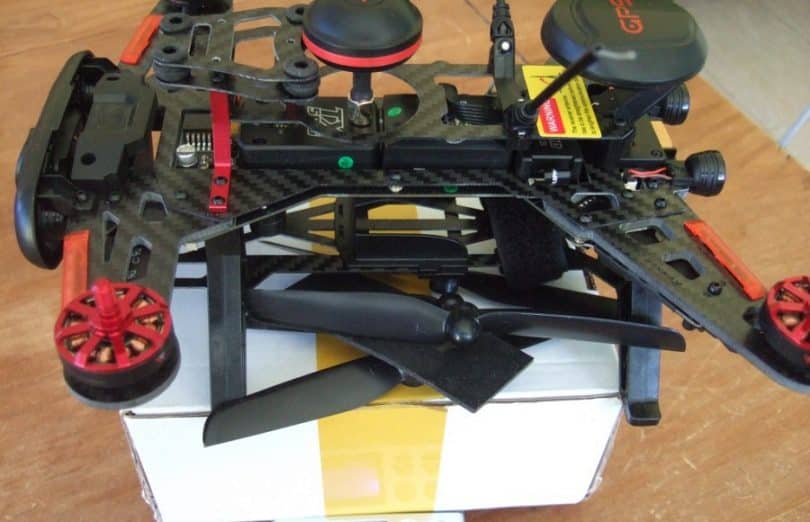
That being said, with the Walkera Runner 250 you will get a lot of value for your money and a lot of enjoyment without having to worry about the standard drone problems.
In regards to the guarantee, the drone comes with the standard warranty, and if the service team spots a technical flaw that stems from the original assembly process, you are eligible for either a replacement drone or a full monetary refund.
UNIQUE FEATURES
The Runner 250 is a very interesting and, at the same time, sturdy and reliable drone. However, it falls a bit short when it comes to unique features.
One of the very few things that this drone brings to the table on its own is the camera that is sports. While there is nothing new about built-in cameras and drones sporting their own digital eyes, this camera is among the most powerful built-in cameras, for this drone price bracket at least.
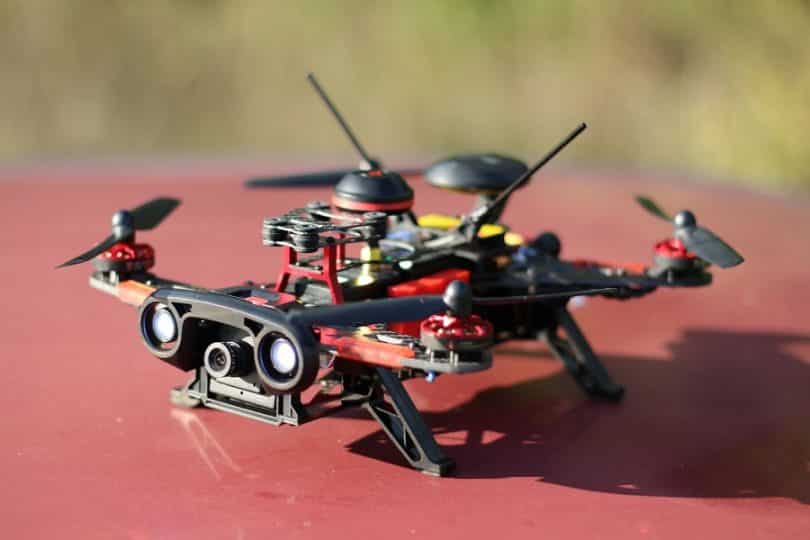
Sadly it does not support in-flight video feedback. Still, the quality of the videos and pictures taken in-flight is still really high.
SIMILAR MODELS of Walkera Runner 250 OR MAIN COMPETITORS
IONIC STRATUS DRONE QUADCOPTER
Right off the bat, you will see that this drone has a design that is sleek, aerodynamic and more or less air-friendly. It has rotor guards in place to protect the propellers in the event of a collision or crash but it is not exactly as sturdy and as durable as the Runner 250.
It is lightweight, easily damaged by a crash, and unable to achieve the same stamina and the same resilience as the Walkera Runner 250.
One of the features that the Ionic Stratus Drone is able to bring to the table is the “headless” feature which allows the pilot to control the drone without having to worry about which end is which. This feature combined with a central pivot point on which the camera rotates actually makes for one of the most stable and balanced flyover shots that you can get with a drone.
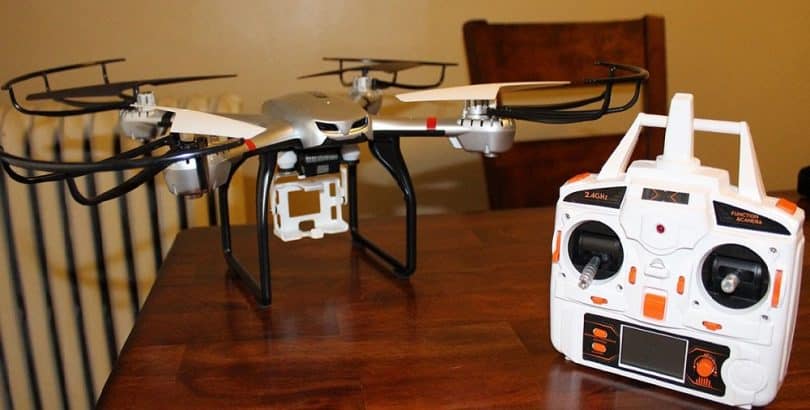
Another key element that makes this drone one of the contenders for comparison with the Walkera Runner 250 is the value for money aspect of the drone, and while it is a drone that is clearly made for photography and shooting videos, it still manages to reach a low price point, similar to racing drones and the Runner 250 in particular. If you want to get more familiar with Ionic’s model, we suggest checking out our Ionic Stratus in-depth review .
EACHINE RACER 250
This one is pretty similar in a lot of ways with the Walkera Runner 250, even packing a small LCD display that can be attached to the controller in order to provide the pilot with a visual feedback of the environment around the drone.
It goes without saying that this neat little monitor is more than helpful for drone pilots, especially when racing against other drones or having to maneuver through more difficult conditions like forests or lush foliage.
Something else that the Racer 250 sports, which ironically is an aspect that most other drone designers have skipped over, is a very powerful set of headlights and taillights. Once you fire those lights off it becomes increasingly difficult to lose track of the drone itself. For much more information on this mdoel, read our Eachine Racer 250 review .
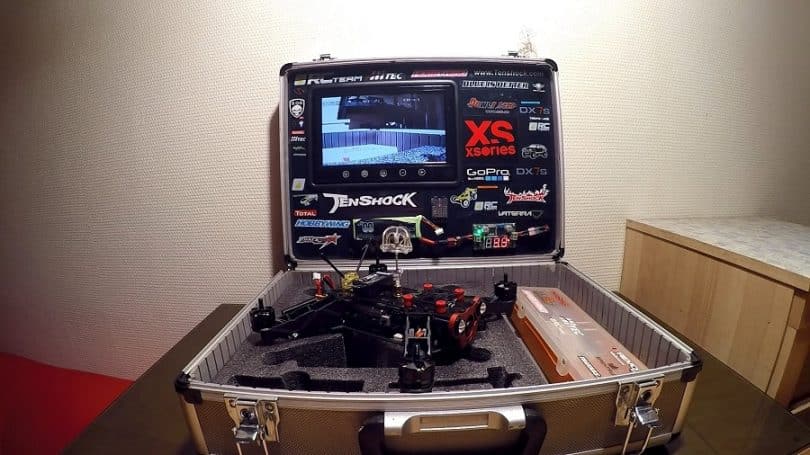
Just like the Runner 250, the Racer 250 is a racing drone, able to reach speeds and heights similar to the Runner 250. It falls horribly short when it comes to impact resistance and simply cannot reach the bar set by the Runner 250.
One last thing to note about the Racer 250 is the fact that even though it might not sport the same amount of resistance and resilience, it manages to pack more stamina, outlasting the Runner 250 in a shoulder to shoulder flight, and due to its lighter frame, it manages to be slightly more nimble and agile.
ARRIS X-SPEED 250B
From a few standpoints, the X-Speed 250B is similar to the Runner 250. They have the same design idea, they are both affordable, and they are both racers. The X-Speed 250B, however, manages to bring something different to the table.
First and foremost, this drone uses vibration dampening plates in order to facilitate the user in obtaining better and much clearer shots with its camera. This not only makes the drone more versatile but also brings an element of stability into the mix, making for tighter controls and overall better responses from the drone.
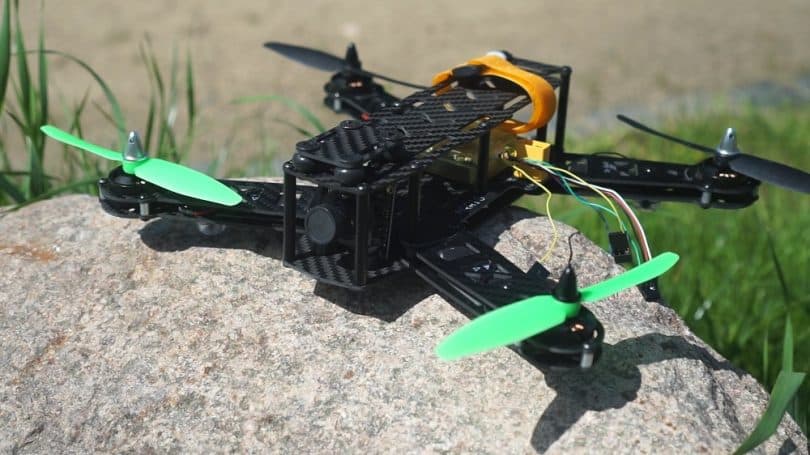
Second, it uses the 2204 motor and the BLHeli 20A ESC. This combination makes the X-Speed 250B more powerful and, at the same time, able to reach higher burst speeds, at the cost of battery power and overall battery life.
The problem the X-Speed has is the antenna, the bulbous piece of equipment that is attached to the top of the drone.
On the Walkera Runner 250, it is placed neatly in the center of the drone, while on the X-Speed 250B it is placed somewhere in the back right corner, throwing the drone off-balance at very high speeds and causing it to be less maneuverable and less stable than the Walkera Runner 250.
OVERVIEW Walkera Runner 250
Let us now have a look at the advantages and disadvantages offered by this product.
Pros:
- Incredibly fast
- Very maneuverable
- Really great value for money
Cons:
- An average flight time of only 12-14 minutes
- It weighs in at 510g
- The maximum cargo weight is severely reduced
In conclusion, the Walkera Runner 250 is a drone that can be great for beginners, being able to take a lot of punishment, while at the same time bring a bit of challenge to the table for the veterans and the more skilled pilots out there.
Summary
The Walkera Runner 250 is a very stable and durable drone. Initially built for racing, it can be adapted for multiple uses and purposes by their users. This drone can take a lot of punishment and can withstand even the harshest of crashes without the vital components being damaged.
